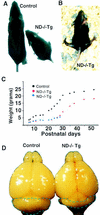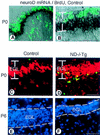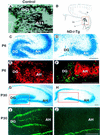NeuroD is required for differentiation of the granule cells in the cerebellum and hippocampus
- PMID: 10398678
- PMCID: PMC316850
- DOI: 10.1101/gad.13.13.1647
NeuroD is required for differentiation of the granule cells in the cerebellum and hippocampus
Abstract
NeuroD, a bHLH transcription factor, is implicated in differentiation of neurons and pancreatic beta cells. NeuroD-null mice die shortly after birth due to severe neonatal diabetes. To examine if there is postnatal neuronal phenotype in these mice, we rescued them from neonatal lethality by introducing a transgene encoding the mouse neuroD gene under the insulin promoter. These mice survive to adulthood but display severe neurological phenotype due to neuronal deficit in the granule layers of the cerebellum and hippocampus. We show here that NeuroD is required for these postnatally generated microneurons to undergo proper differentiation, the absence of which results in cell death.
Figures





Similar articles
-
Atypical mouse cerebellar development is caused by ectopic expression of the forkhead box transcription factor HNF-3beta.Gene Expr. 2001;9(4-5):217-36. doi: 10.3727/000000001783992597. Gene Expr. 2001. PMID: 11444531 Free PMC article.
-
Neuronal basic helix-loop-helix proteins (NEX and BETA2/Neuro D) regulate terminal granule cell differentiation in the hippocampus.J Neurosci. 2000 May 15;20(10):3714-24. doi: 10.1523/JNEUROSCI.20-10-03714.2000. J Neurosci. 2000. PMID: 10804213 Free PMC article.
-
Neuronal basic helix-loop-helix proteins (NEX, neuroD, NDRF): spatiotemporal expression and targeted disruption of the NEX gene in transgenic mice.J Neurosci. 1998 Feb 15;18(4):1408-18. doi: 10.1523/JNEUROSCI.18-04-01408.1998. J Neurosci. 1998. PMID: 9454850 Free PMC article.
-
NeuroD: the predicted and the surprising.Mol Cells. 2004 Dec 31;18(3):271-88. Mol Cells. 2004. PMID: 15650322 Review.
-
NeuroD and neurogenesis.Dev Neurosci. 1997;19(1):27-32. doi: 10.1159/000111182. Dev Neurosci. 1997. PMID: 9078430 Review.
Cited by
-
The insulin regulatory network in adult hippocampus and pancreatic endocrine system.Stem Cells Int. 2012;2012:959737. doi: 10.1155/2012/959737. Epub 2012 Sep 4. Stem Cells Int. 2012. PMID: 22988465 Free PMC article.
-
Aryl hydrocarbon receptor deletion in cerebellar granule neuron precursors impairs neurogenesis.Dev Neurobiol. 2016 May;76(5):533-50. doi: 10.1002/dneu.22330. Epub 2015 Aug 17. Dev Neurobiol. 2016. PMID: 26243376 Free PMC article.
-
The neurogenic factor NeuroD1 is expressed in post-mitotic cells during juvenile and adult Xenopus neurogenesis and not in progenitor or radial glial cells.PLoS One. 2013 Jun 14;8(6):e66487. doi: 10.1371/journal.pone.0066487. Print 2013. PLoS One. 2013. PMID: 23799108 Free PMC article.
-
Regeneration of Xenopus laevis spinal cord requires Sox2/3 expressing cells.Dev Biol. 2015 Dec 15;408(2):229-43. doi: 10.1016/j.ydbio.2015.03.009. Epub 2015 Mar 19. Dev Biol. 2015. PMID: 25797152 Free PMC article.
-
Atypical mouse cerebellar development is caused by ectopic expression of the forkhead box transcription factor HNF-3beta.Gene Expr. 2001;9(4-5):217-36. doi: 10.3727/000000001783992597. Gene Expr. 2001. PMID: 11444531 Free PMC article.
References
-
- Alpert S, Hanahan D, Teitelman G. Hybrid insulin genes reveal a developmental lineage for pancreatic endocrine cells and imply a relationship with neurons. Cell. 1988;53:295–308. - PubMed
-
- Altman J. Postnatal growth and differentiation of the mammalian brain, with implications for a morphological theory of memory. In: Quarton GC, Melnechuk T, Schmitt FO, editors. The neurosciences. New York, NY: The Rockefeller University Press; 1967. pp. 723–743.
-
- Altman J, Bayer SA. Mosaic organization of the hippocampal neuroepithelium and the multiple germinal sources of dentate granule cells J. Comp Neurol. 1990;301:325–342. - PubMed
-
- Ben-Arie N, Bellen HJ, Armstrong DL, McCall AE, Gordadze PR, Guo Q, Matzuk MM, Zoghbi HY. Math1 is essential for genesis of cerebellar granule neurons. Nature. 1997;390:169–172. - PubMed
-
- Gage FH, Kempermann G, Palmer TD, Peterson DA, Ray J. Multipotent progenitor cells in the adult dentate gyrus. J Neurobiol. 1998;36:249–266. - PubMed
Publication types
MeSH terms
Substances
Grants and funding
LinkOut - more resources
Full Text Sources
Other Literature Sources
Molecular Biology Databases
